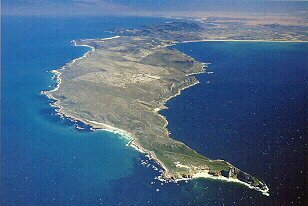 The Cape
of Good Hope Nature Reserve forms part of the Cape
Peninsula National Park, and is managed by the South
African National Parks. Together with the World Wildlife
Fund (WWF), the World Bank and Global Environment
Facility, this area will be declared an International
Heritage Site. The Cape
of Good Hope Nature Reserve forms part of the Cape
Peninsula National Park, and is managed by the South
African National Parks. Together with the World Wildlife
Fund (WWF), the World Bank and Global Environment
Facility, this area will be declared an International
Heritage Site.There are three promontories here at the end of the Cape Peninsula. The first is Cape Point itself. The next is Cape Maclear which lies to the west, separated from Cape Point by the sandy expanse of Dias Beach. The third promontory is the "Cape of Good Hope". Declared by many authors to be "the most famous promontory in the world", It was Bartholomeus Dias who named this the "Cape of Good Hope" and not the "Cape of Storms" as is widely believed. Bartholomeus Diaz was the first person to circumnavigate the Cape in 1488 and named it "Cape of Storms". Vasco da Gama rounded the Cape on 22nd November 1497. This led to the establishment of the Cape sea route. It is fair to say that the Cape of Good Hope lies at the maritime crossroads of the world and that it is here that East met West. In the late 1850’s it was decided to erect a lighthouse at Cape Point. The location chosen was on Cape Point Peak (238 metres above sea level). However, due to it's height the lighthouse was often obscured by clouds and mist. With the wreck of the Portugese liner the "Lusitania" on April 18, 1911 the decision was taken to move the Cape Point light to its present location above Dias Point where it now stands, only 87 metres above sea-level. In the 17th century a
Dutch Captain, Hendrick van der Decken, attempted to
round the Cape in strong headwinds. Mysteriously his ship
and crew disappeared, but the saga is immortalised in the
legend of the ghost ship "The Flying Dutchman",
which has allegedly been sighted by a number of
witnesses. |